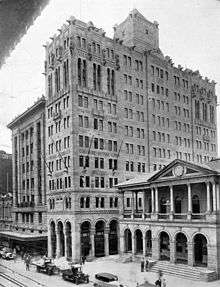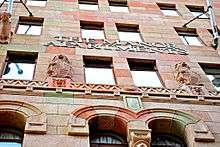Manor Apartment Hotel

The Manor Apartment building is a heritage-listed former insurance office building located at 289 Queen Street, Brisbane, Queensland, Australia. It is currently used as an apartment hotel.
History
Prior to the current building
The Queensland Branch of Colonial Mutual Life Assurance Society (CML) was formed in June 1874 and in 1883 the society built offices at 62 Queen Street. In August 1906, CML purchased this site at 289 Queen Street, adjacent to the General Post Office in the heart of the Brisbane Central Business District, and constructed offices.
Current building
In September 1930 it was announced that the existing offices would be demolished to enable the construction of a new commodious building on the site for the expanding society (the current building). To compensate for the site's narrow frontage of 33 feet (9.9 metres), an agreement was made between the Commonwealth authorities, who administer the adjoining GPO, and CML to allow a "right-of-way to extend the full depth of the building".[1] In October 1930, the yet-to-demolished buildings sustained some damage following a fire;[2] however, the fire was not the reason for the construction of the current building (as some sources suggest) as the plans had already been announced a month earlier. Demolition of the old offices was underway by November 1930[3] with construction of the current building well underway by February 1931.[4]
Between 1925 and 1934 much of the south side of Queen Street was redeveloped, including National Mutual Life Association Building (1926), the Commonwealth Bank (1929) and the AMP Building (1931-4).
Construction
The Benedict stone used for the facing, a mixture of cement and crushed Brisbane tuff was manufactured by Benedict Stone (Qld) Pty Ltd which was established by Archbishop James Duhig to manufacture the stone required for the Holy Name Cathedral, Fortitude Valley. The product was developed at the turn of the twentieth century by American manufacturer, Benedict. Duhig obtained a licence from America and opened the Benedict Stone works at Bowen Hills on 9 August 1929. In February 1930 CML advanced Duhig a 70,000 mortgage on his properties which included the stone works. A mutually dependent relationship developed between CML, Duhig and Jack Hennessey, architect. CML used Benedict stone to build a number of their Australian offices, ensuring some of their mortgage was repaid and employed Hennessey and Concrete Construction (Qld) Ltd, Brisbane. Concrete Construction (Qld) Ltd also built the CML offices in Sydney and Melbourne. George Harvey was responsible for the masonry work on the building and may have created the gargoyles on the façade. The stone was delivered and positioned within seven months, setting an Australian record for stonework. Built during an economic depression, its construction provided employment for many Queensland workers.
Opening
On 12 November 1931 the CML building was officially opened by the Governor, Lieutenant-General Sir John Goodwin. The ground floor provided offices for Colonial Mutual and the arcade leading to Queen Street contained retail premises. The offices and professional suites on the upper floors were available for lease.
Later owners
Queensland Newspapers purchased the site in September 1983, cleaned and repaired the exterior and re-opened the building as Newspaper House on 11 September 1985.
Heritage Listing
The building was listed on the Register of the National Estate in 1987.[5] However, that register no longer has any statutory significance.
The building was listed in the Queensland Heritage Register in 1992.[6]
Architectural Description

This inter-war commercial building is ten storeys high with a narrow frontage to Queen Street and a long side elevation. It has been designed in sympathy with adjoining buildings, matching the facade of the GPO at its base and responding to the parapet line of Custom Credit House in its upper levels. The building has a concrete encased steel frame with concrete floors and is faced in Benedict Stone the colours of which range from green to pink. The style of the sculptured ornament on the building facades is influenced by American Art Deco buildings of this period, as well as containing some Norman influence. It is similar in style to interstate Colonial Mutual Life Assurance Society Ltd buildings.
The building has three paired window bays across the Queen Street façade. Three double height arched openings occur at the ground floor level. On the level above are paired window openings with arched heads and a central ornamented column. The two levels below the top floor have paired window bays which are similar but double the height. At the base of these is an imitation balcony with balusters supported on brackets. In this way the building has both a distinctive top and base. A similar projecting balcony occurs in front of the central window bay on the level below. Above the double height bays at the base of the top level sculptured lions stand on projecting brackets. The one facing the corner is winged. The parapet has raised portions each with a projecting stylized eagle "gargoyle". Similar gargoyles appear in the same location a level below and also below each projecting flag post above the third floor.
The entire Queen Street façade is repeated at each end of the side elevation, the central bays of which are plainer. Behind the parapet the building has an interesting roofscape of steeply pitched terracotta tiled roofs, one above the caretakers quarters and another over the lift room on the eleventh floor. At street level individual awnings have been located between the archways. From the rear laneway the building duplicates much of the front façade but is painted.
Internally the original detailing remains in the fire stairs, including the handrail and tiled landings. All the levels have been refurbished with suspended ceilings that sit below the window heads.
The building was used as a stand in for a New York City skyscraper in the 1996 film The Phantom.
Current use
In 1994, the building was converted and fully refurbished to become an apartment hotel, The Manor Apartments, comprising 46 studio, one- and two-bedroom apartments each with its own fully equipped kitchen and laundry and separate and fully furnished bedrooms and living areas. The apartments are air-conditioned, but windows may still be opened. The 1930s origins of the building are still evident in the classically spacious and high-ceiling interiors and in the special stonework and sculptures.
References
- ↑ "NEW BUILDING.". The Brisbane Courier. National Library of Australia. 17 September 1930. p. 16. Retrieved 28 May 2013.
- ↑ "State Treasurer's Proposals to Balance Budget. CITY BLAZE.". The Brisbane Courier. National Library of Australia. 16 October 1930. p. 13. Retrieved 28 May 2013.
- ↑ "The Brisbane Courier. PICTORIAL NEWS BUDGET.". The Brisbane Courier. National Library of Australia. 15 November 1930. p. 16. Retrieved 28 May 2013.
- ↑ "BUILDING AND REAL ESTATE Building Operations—Interesting Statistics—New Shell Company Building—Tenders—Forthcoming Sales.". The Brisbane Courier. National Library of Australia. 27 February 1931. p. 4. Retrieved 28 May 2013.
- ↑ "Newspaper House (former), 289-291 Queen St, Brisbane City, QLD, Australia". Australian Heritage Database. Australian Government. Retrieved 28 May 2013.
- ↑ "Newspaper House (entry 600150)". Queensland Heritage Register. Queensland Heritage Council. Retrieved 13 July 2015.
External links
- Official website The Manor Apartments Hotel
Coordinates: 27°28′03″S 153°01′42″E / 27.46755°S 153.02825°E